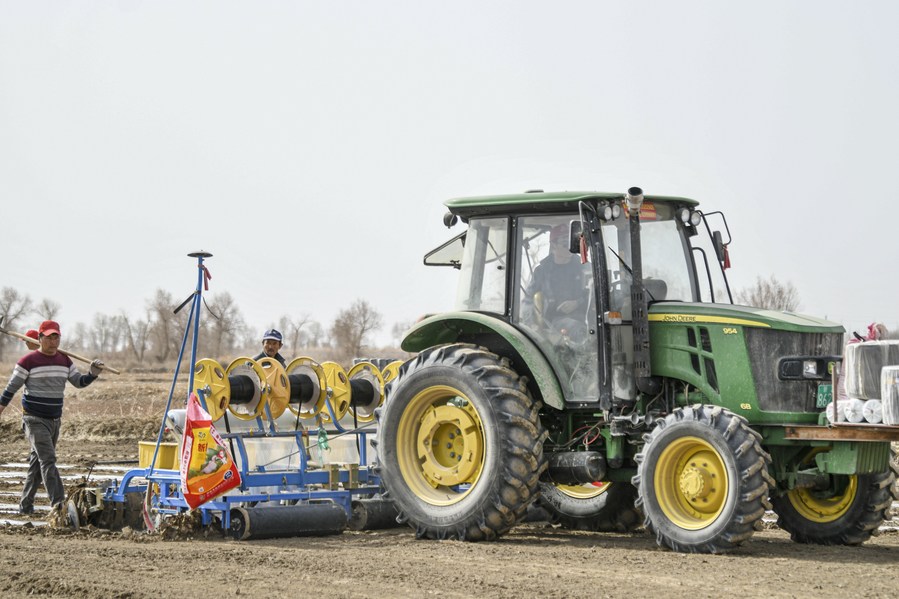New tech drives rural development across China
As China has continuously improved the digital infrastructure in rural areas, various places across the country are boosting rural development and advancing rural revitalization by making use of these innovative facilities.

A seeding machine equipped with the Beidou Navigation Satellite System is at work in a cotton field in Yuli County, northwest China's Xinjiang Uygur Autonomous Region, March 30, 2023. (Xinhua/Wang Fei)
Many places have jumped on the livestream bandwagon, promoting local agricultural products online. In an e-commerce company in Dandong, northeast China's Liaoning Province, two young salespersons promoted strawberries, a local specialty, on a short-video platform. The duo, with one introducing the product to the viewers and another checking on inventory and price, quickly sold over 80 crates of strawberries.
Thanks to the online platform, sales of the company has increased, with some repeat orders. A dessert shop in southwest China's Yunnan Province, for example, has purchased strawberries from the company in many strawberry seasons, according to a company executive.
Similarly, peach grower Li Xiqing in Laowan village, Liuping township, Qin'an county, northwest China's Gansu Province, started to sell his peaches in his WeChat Moments (a platform that allows users to share images and texts) two years ago. Some e-commerce companies later came to his peach orchard to buy peaches from him. "In the past, I had to go elsewhere with my peaches to look for buyers, which is very time-consuming and exhausting. And there were times when I failed to sell them," he said. With the e-commerce platforms and logistic networks, Li can easily sell his peaches while gaining more income.
Livestreams and short-video platforms stimulate the needs of consumers. The two innovative approaches can provide more job opportunities for farmers, generate wealth for them, and help high-quality farm produce hit the market, said Sun Dongsheng, a researcher at the Institute of Agricultural Economics and Development of the Chinese Academy of Agricultural Sciences (CAAS).
Regions across the country have applied intelligent facilities to their farm work. According to an official of a service center in Shanying village, Jiaxiang county, east China's Shandong Province, the harvesters and planters of the village are all equipped with the BeiDou Navigation Satellite System. To operate the machines, the operators simply need to input the map into them, and plan the route. Then the machines will accurately work along the route, greatly improving work efficiency.
Cailu village, Dongyang city, east China's Zhejiang Province, has built an online platform to monitor the farmland. Information about the fields, such as what nutrients the fields lack, and which and when the seeds were planted, can be easily obtained from a screen in a service center of the village. "Thanks to the technical support, efficiency has been enhanced," said Lu Yangchun, head of the village.
Meantime, southwest China's Guizhou Province launched an application, allowing farmers to check a wide range of information such as favorable policies, utilization of funds, and rural collective resources. "Such information has a bearing on our lives, so I frequently check them on the application, especially all kinds of subsidies," said a villager surnamed Jian.
A report of the digital development in rural China of 2022 released by the Ministry of Agriculture and Rural Affairs said that by the end of last year, all of China's county seats have been covered by 5G networks, and all of China's administrative villages have been connected to broadband internet services. China's online retail sales in rural areas reached 2.17 trillion yuan ($301 billion). And village-level comprehensive service centers empowered by digital technologies hit 483,000 across the country.
Photos
Related Stories
- China's achievements in agriculture, poverty reduction inspire other developing countries, says Ghanaian official
- Visionary entrepreneur revitalizes pear industry in remote mountain village
- Exploring natural solutions for farmland sustainability
- Tech makes summer harvesting, sowing, management more efficient
- Digital technicians help farmers work smart
- China's bumper harvest brings confidence amid global inflation
Copyright © 2023 People's Daily Online. All Rights Reserved.









